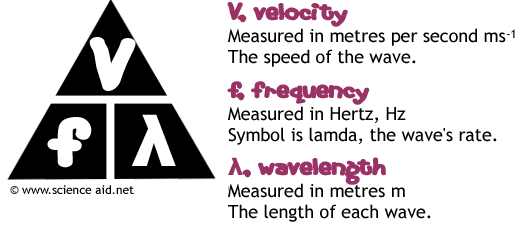

(click picture to get full view)
Crest or peak: The highest point reached by a wave.
Trough: The lowest point reached by a wave.
Phase : Any Two sources of wave motion are said to be in phase if, at any moment, they have the same fractional displacement from the rest position and are moving in the same direction. If both conditions are not met the sources are out of phase.
Any two crests or troughs are always in phase
Wavelength : The shortest distance between any two points in a wave that are in phase.In a transverse wave, the points are two successive crests or troughs.In longitudinal wave, it is the distance between two successive compressions or rarefactions.S.I. Unit: Metre (m)
Amplitude : The maximum displacement (difference between an original position and a later position) of the material that is vibrating. Amplitude can be thought of visually as the highest and lowest points of a wave.It is the height of a crest or the depth of the trough measured from rest position.S.I. Unit: Metre(m)
In a longitudinal Wave,

(click picture to get full view)
Compression : A point on a medium through which a longitudinal wave is traveling which has the maximum density.It is a region where the coils are pressed together in a small amount of space.
Rarefaction : a point on a medium through which a longitudinal wave is traveling which has the minimum density.It is a region where the coils are spread apart, thus maximizing the distance between coils.

The wavelength of a wave is the length of one complete cycle of a wave. For a transverse wave, the wavelength is determined by measuring from crest to crest. A longitudinal wave does not have crest; so how can its wavelength be determined? The wavelength can always be determined by measuring the distance between any two corresponding points on adjacent waves. In the case of a longitudinal wave, a wavelength measurement is made by measuring the distance from a compression to the next compression or from a rarefaction to the next rarefaction
Questions:
Consider the diagram below in order to answer questions #1-2.

1. The wavelength of the wave in the diagram above is given by letter ______.
ANS
2. The amplitude of the wave in the diagram above is given by letter _____.
ANS
3. Indicate the interval which represents one full wavelength.

a. A to C
b. B to D
c. A to G
d. C to G
ANS
Displacement-Distance Graph
A wave:

Any points on graph above the rest position show positive displacements
and any points on graph below the rest position show negative displacement.
(click picture to get full view)
Displacement-Time Graph

If we freeze the wave motion at various times, we can observe the up-and-down movements of points on transverse wave.If we trace the movement of wave over one second ,we can obtain the displacement-time graph of wave.
Period (T): It is the time for a particle on a medium to make one complete vibrational cycle. Period, being a time, is measured in units of time such as seconds, hours, days or years.
Frequency(f) : It refers to how often the particles of the medium vibrate when a wave passes through the medium. S.I. unit: Hertz (Hz)where 1 Hz is equivalent to 1 cycle/second.
Frequency = Number of cycles/Time Interval
(The period (T) is the time required to complete one full cycle.)
Period and frequency exhibit a reciprocal relationship.

Since the symbol f is used for frequency and the symbol T is used for period, these equations are also expressed as:

Higher the frequency, more the no. of waves produced in one second,T is shorter.
Wave Speed (v) : In a time of one period, a crest on a transverse wave will have moved a distance of one wavelength.
Hence,
Equation for the Speed of a wave :
v : L/T
where ,
v- wave speed
L- wavelength
T-Period
Since f:1/T,
v:f x L

S.I. unit : m/s
Wave front: It is the imaginary line on a wave that joins all points that are in the same phase.It is usually drawn by joining all the wave crests.Depending on the formation of waves, wavefront can be concentric circles,plane straight lines or any shape.

Questions:
1. As the frequency of a wave increases, the period of the wave ___________.
a. decreases
b. increases
c. remains the same
ANSWER
2.The period of the sound wave produced by a 440 Hertz tuning fork is ___________.
Answer
3.A child in a swing makes one complete back and forth motion in 3.2 seconds. This statement provides information about the child's
a. speed
b. frequency
c. period
ANSWER
4. A period of 5.0 seconds corresponds to a frequency of ________ Hertz.
a. 0.2
b. 0.5
c. 0.02
d. 0.05
e. 0.002
Answer
No comments:
Post a Comment